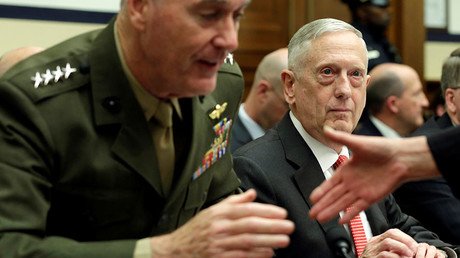The United States’ current strategy in Afghanistan is non-existent, and it will take a few weeks to put one together, Defense Secretary Jim Mattis admitted during a hearing about the Pentagon budget. Senators threatened to cut funding without a strategy.
Mattis and Chairman of the Joint Chiefs of Staff General Joseph Dunford testified before the Senate Armed Services Committee on Tuesday, discussing how the Pentagon’s budget will be used to address a myriad of issues, from troop use in Afghanistan and Syria to media reports of cyber threats from Russia.
Dunford began his remarks by asking for more money for the military, which has been hampered since 2013 by a set of prescribed budget cuts known as sequestration.
The United States’ “competitive advantage is eroding,” he said. Since 9/11, war has accelerated wear and tear on equipment and troops, Dunford explained. While the US was focused on terrorism, potential adversaries have invested in technologies intended to "limit our ability to project power," he added.
Senator John McCain (R-Arizona) questioned whether the US is throwing good money after bad in Afghanistan, because the Pentagon doesn’t appear to have a strategy.
“We can’t keep going like this. You can’t expect a stable budget if you don’t give us a strategy,” McCain said. “Right now, we have a ‘don’t lose’ strategy, which is not winning.”
"We are not winning in Afghanistan right now. And we will correct this as soon as possible," Mattis admitted, describing the current period as "a strategy-free time.” The Pentagon is working to put one together, and Congress should expect it “very shortly,” he said.
McCain then threatened that if the Pentagon doesn’t come up with a strategy for Afghanistan soon, “you’re going to get a strategy from us.”
The lack of a strategy is leading to losses on the battlefield, both men told Sen. Joe Donnelly (D-Indiana) when he asked: “Are we better shape now than last year?”
“I think the Taliban had a good year last year,” Mattis said. “Right now, I believe the enemy is surging.”
Despite the uncertainty about US operations in Afghanistan, though, American troop presence is still an insurance policy against another 9/11, Mattis told Sen. Lindsey Graham (R-South Carolina.
Afghanistan is the center of international terrorism, he said. “We’ve got to confront them there.”
The US currently has 8,500 troops in Afghanistan, who are either providing support to Afghan troops or hunting various terrorist groups throughout the mountainous country. The upcoming strategy would include a regional approach with more contributions from NATO allies, Mattis said. There are about 5,000 troops from the alliance, and some of the 28 member countries have pledged to add more in recent months.
Another priority for the new strategy would be to reduce Afghan casualties by “more effectively assisting” Afghan ground forces through increasing US fire and air support, Dunford said. Afghan forces have suffered 15,000 casualties, including more than 5,000 killed, over the first eight months of 2016.
In contrast to the lack of a strategy in Afghanistan, there is a “defeat ISIS” strategy in Syria which the US-led coalition seeks to “encircle and destroy” Islamic State (IS, formerly ISIS/ISIL) fighters. Another facet of that strategy is President Donald Trump’s decision in early May to arm the Syrian Kurds, Mattis said.
Since then, the coalition has taken down Manbij and targeted Raqqa, the de facto IS capital. The Syrian Democratic Forces (SDF) offensive on Raqqa began last Monday, and the fighting is inside the city now. US Apache helicopters and Marine howitzers are supporting the SDF ground forces.
Sen. Jeanne Shaheen (D-New Hampshire) asked the Pentagon leaders about reports that Russian troops cut off Americans in al-Tanf and blocked the US from the Euphrates, and if that was expected.
While Mattis said he did not anticipate the Russians’ move at Tanf, it did not surprise the DOD analysts. Syrian President Bashar Assad is "flexing his muscle” and moving to break through to the surrounded government garrison in Deir-ez-Zor.
“Media reports of us being encircled are not accurate,” Dunford added.
US-led coalition airplanes have launched airstrikes against Syrian government forces on three occasions over the past month, accusing them of endangering the US-backed rebels based at Al-Tanf. Russian Foreign Minister Sergey Lavrov denounced the bombing as “illegitimate and unlawful” and “yet another harsh violation of Syria’s sovereignty.”
After the third airstrike, General Sergey Surovikin of the Russian ground forces accused the US coalition of “colluding” with IS by interfering with the Syrian military’s efforts to fight against the terrorists.
The US and Russia, which backs the government in Damascus, are communicating with each other solely to ensure the safety of their planes in the air, because the National Defense Authorization Act restricts any kind of military cooperation, Dunford said – adding that Mattis could waive that restriction for national security reasons if needed.

